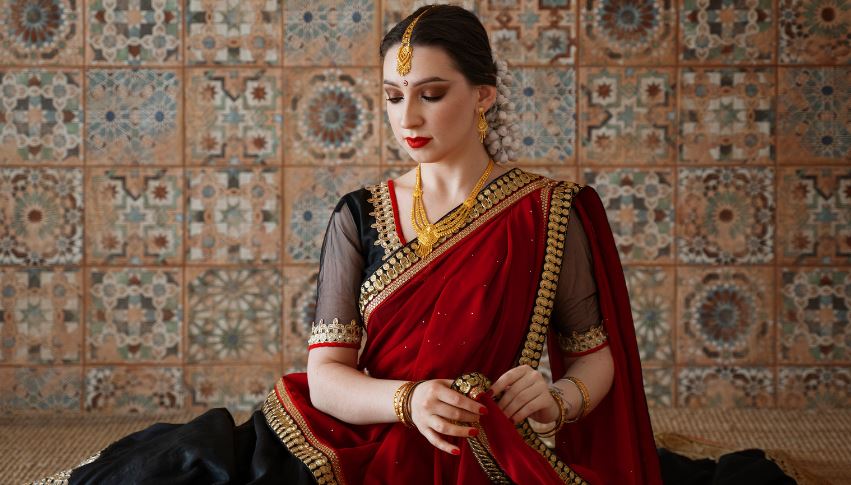Gujarat’s traditional attire is a vibrant reflection of its rich cultural heritage, blending elegance, comfort, and symbolism. From the graceful Ghagra Choli worn by women to the striking Kediya donned by men, each piece tells a story of the state’s history and festivities.
These outfits, adorned with intricate embroidery, mirror work, and vivid colours, are more than just clothing – they represent Gujarat’s deep-rooted traditions and the spirit of celebration.
In this guide, we explore the top 10 man woman traditional dress of Gujarat, highlighting their cultural significance and timeless beauty.
What Is the Significance of Traditional Gujarati Attire During Festivals Like Navratri?
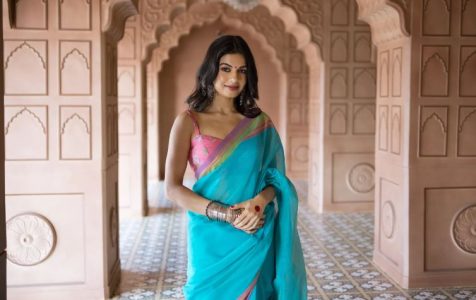
Traditional Gujarati attire, such as the Kediya, Ghagra Choli, and Chaniya Choli, plays a vital role during festivals like Navratri. These garments reflect the state’s cultural vibrancy and are designed for the energetic dances of Garba and Dandiya.
Men wear colourful, pleated Kediya with Chorno, while women don bright Ghagra Cholis or Chaniya Cholis with intricate embroidery and mirror work. The outfits not only symbolise Gujarat’s artistic heritage but also allow free movement, essential for dancing.
Wearing these traditional garments during festivals helps preserve cultural identity, making them an integral part of Gujarat’s festive celebrations.
What Makes the Patola Saree Unique Among Traditional Gujarati Clothing?
The Patola saree stands out due to its intricate double ikat weaving technique, a complex process where both warp and weft threads are dyed before weaving.
Originating from Patan, Gujarat, this saree is renowned for its geometric patterns, vibrant colours, and rich texture, often symbolising prosperity and luxury.
Each Patola saree takes months to hand-weave, showcasing the artisan’s skill and dedication. These sarees are often worn during weddings and significant cultural events, making them not only a fashion statement but also a representation of Gujarat’s textile craftsmanship.
The time-intensive process and cultural significance make the Patola saree a prized possession.
Why Is the Kediya Considered an Iconic Piece of Gujarati Men’s Attire?
The Kediya is an iconic piece of men’s traditional attire in Gujarat, particularly during festivals like Navratri. Its flared, pleated design allows for freedom of movement, making it ideal for energetic Garba and Dandiya dances.
Traditionally paired with Chorno, a tight-fitting lower garment, the Kediya is made from breathable fabrics like cotton or silk, ensuring comfort during long celebrations. The vibrant colours and mirror work reflect the state’s festive spirit.
The Kediya not only embodies Gujarat’s pastoral traditions but also continues to be a popular garment, with modern versions incorporating more elaborate designs.
How Does the Bandhani Saree Represent Gujarat’s Textile Heritage?
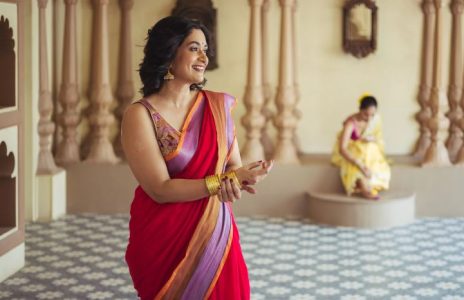
The Bandhani saree is a hallmark of Gujarat’s textile tradition, celebrated for its unique tie-dye process. This method involves tying small sections of the fabric and dyeing them to create intricate patterns, often seen in bright colours like red, yellow, and green.
Each saree is hand-crafted by artisans, with the patterns symbolising different aspects of Gujarati culture. Commonly worn during weddings and festive occasions, Bandhani sarees are lightweight and comfortable, making them suitable for both casual and formal events.
Their blend of artistry and practicality represents Gujarat’s rich textile heritage, making them a beloved choice among Gujarati women.
What Role Does the Chaniya Choli Play in Gujarati Festivals and Weddings?
The Chaniya Choli is a vibrant, festive outfit for Gujarati women, especially popular during Navratri and weddings. It consists of a flared skirt (Chaniya), a fitted blouse (Choli), and a Dupatta.
Richly decorated with embroidery, mirror work, and bright colours, the Chaniya Choli is essential for Garba and Dandiya performances, allowing women to move freely while dancing.
In weddings, this attire takes on a more elaborate form with heavier embellishments, making it a visually striking outfit. The Chaniya Choli not only reflects Gujarat’s festive spirit but also serves as a symbol of cultural pride and tradition.
Top 10 Man Woman Traditional Dress of Gujarat
1. Kediya (Men)
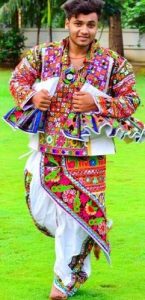
Image – Source
The Kediya is a distinct traditional garment worn by men in Gujarat, particularly during Navratri celebrations. This short, pleated upper garment features vibrant colours and is adorned with intricate mirror work.
It is designed to allow ease of movement, making it perfect for the energetic Garba and Dandiya dances. The Kediya represents the spirit of Gujarat’s pastoral roots.
The Chorno, a tight-fitting lower garment, is often paired with the Kediya. This combination offers comfort and flexibility, important for the lively and spirited Garba festivities.
The design incorporates both tradition and practicality, making it a popular choice during festivals and community gatherings. The outfit is often accessorised with a Paghdi or traditional headgear.
While Kediya is traditionally associated with festivals, its influence has spread into modern fashion. Designers now create contemporary versions with intricate embroidery and embellishments, making this attire a stylish blend of Gujarat’s heritage and modern aesthetics. The Kediya continues to be an iconic symbol of Gujarati men’s traditional wear.
Kediya Dress Features
| Attribute | Details |
| Dress Name | Kediya (for men) |
| Cultural Importance | Reflects Gujarat’s pastoral traditions, worn by men during festivals. |
| Fabric & Material | Typically made from breathable cotton or silk. |
| Key Design Features | Short, flared top with pleats, paired with Chorno (tight-fitting pants). |
| Wearing Style | Worn with dhoti or churidar, often with a turban for added flair. |
| Special Occasion Use | Popular during Navratri and other cultural festivals. |
| Cultural Accessories | Paired with Paghdi and accessories like earrings. |
| Historical Background | Represents Gujarat’s farming communities. |
| Regional Differences | Variations in pleats and mirror work based on local traditions. |
| Color Palette | Bright colours like red, yellow, blue, adorned with mirror work. |
| Contemporary Trends | Modern designers create embellished versions for fashion-forward men. |
| Artisan Craftsmanship | Handcrafted by local artisans using traditional embroidery techniques. |
| Comfort & Practicality | Lightweight and breathable, ideal for energetic dances. |
| Symbolic Meaning | Represents the vibrancy and resilience of Gujarat’s rural communities. |
| Festive Significance | Essential attire for Navratri, symbolising the cultural unity of Gujarat. |
| Market Availability & Price | Easily available in local markets, with variations in price based on craftsmanship. |
2. Ghagra Choli (Women)
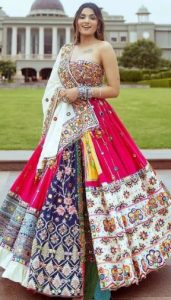
Image – Source
The Ghagra Choli is one of the most beloved and widely worn traditional outfits for Gujarati women. It consists of a long, flowing skirt (Ghagra) and a matching or contrasting blouse (Choli), often accompanied by a Dupatta (scarf). Richly embroidered with intricate patterns and mirror work, this outfit is highly popular during festivals like Navratri.
The elegance of the Ghagra Choli lies in its vivid colours and embellishments, which make it stand out during festive events, particularly Garba and Dandiya nights.
The fabric is typically light and breathable, ensuring comfort even during long hours of dancing. Its adaptability makes it a favourite across both rural and urban areas of Gujarat.
While the traditional Ghagra Choli remains timeless, contemporary versions now blend modern designs with ethnic motifs.
Fashion designers have embraced the garment, adding elements like sequins and embroidery, giving it a fresh, fashionable twist while preserving its cultural essence.
Ghagra Choli Dress Features
| Attribute | Details |
| Dress Name | Ghagra Choli (for women) |
| Cultural Importance | Embodies Gujarati women’s traditional attire, worn during festivals. |
| Fabric & Material | Usually made from silk, cotton, or synthetic blends. |
| Key Design Features | Long skirt (Ghagra) with a fitted blouse (Choli), adorned with embroidery. |
| Wearing Style | Paired with a dupatta, often draped over one shoulder. |
| Special Occasion Use | Worn during festivals like Navratri, weddings, and cultural celebrations. |
| Cultural Accessories | Paired with heavy silver jewellery, bangles, and anklets. |
| Historical Background | Has roots in Gujarat’s rural communities, evolving over time. |
| Regional Differences | Style and embellishments vary across regions. |
| Color Palette | Bright colours like red, pink, yellow, often with gold or silver work. |
| Contemporary Trends | Modern versions incorporate sequins, beads, and designer touches. |
| Artisan Craftsmanship | Often hand-embroidered, featuring traditional patterns and mirror work. |
| Comfort & Practicality | Light and flowing, allowing freedom of movement during dance. |
| Symbolic Meaning | Represents femininity, grace, and the vibrant culture of Gujarat. |
| Festive Significance | A must-have for Navratri and other Gujarati festivals. |
| Market Availability & Price | Available in local and designer boutiques, with a range of price points. |
3. Dhoti and Kurta (Men)
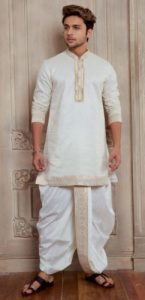
Image – Source
The Dhoti and Kurta is a classic outfit worn by Gujarati men, especially in rural areas and on formal occasions. The Dhoti is a long piece of fabric wrapped around the waist and legs, while the Kurta is a loose-fitting upper garment. Together, they offer a comfortable yet elegant look, ideal for both everyday wear and special events.
The Dhoti is usually made of cotton or silk, making it a breathable and lightweight choice for Gujarat’s warm climate. The Kurta, often embroidered or simply designed, complements the Dhoti, creating a sophisticated appearance.
This combination is especially favoured during festivals like Diwali and traditional religious ceremonies.
In contemporary times, the Dhoti Kurta has been reinvented by designers who add modern touches like bold prints and unique cuts. This traditional outfit, once a staple of rural Gujarat, continues to hold cultural significance, symbolising simplicity and elegance.
Dhoti and Kurta Features
| Attribute | Details |
| Dress Name | Dhoti and Kurta (for men) |
| Cultural Importance | Represents traditional men’s wear in Gujarat, especially in rural areas. |
| Fabric & Material | Usually made from cotton or silk, for breathability. |
| Key Design Features | Simple, loose-fitting kurta paired with a wrapped dhoti. |
| Wearing Style | Dhoti is tied around the waist and legs, Kurta is worn loosely over it. |
| Special Occasion Use | Worn during festivals, religious ceremonies, and weddings. |
| Cultural Accessories | Often paired with sandals and a simple turban. |
| Historical Background | Rooted in Gujarat’s rural and agrarian lifestyle. |
| Regional Differences | Variations in how the dhoti is tied, based on regional customs. |
| Color Palette | Commonly seen in white, cream, and pastel colours. |
| Contemporary Trends | Modern designers incorporate bolder prints and fitted kurtas. |
| Artisan Craftsmanship | Handwoven fabrics are often used, made by local weavers. |
| Comfort & Practicality | Lightweight and airy, perfect for Gujarat’s hot climate. |
| Symbolic Meaning | Represents tradition, simplicity, and the agrarian heritage of Gujarat. |
| Festive Significance | Worn during Diwali, Holi, and other cultural celebrations. |
| Market Availability & Price | Easily found in local markets, priced affordably for everyday wear. |
4. Bandhani Saree (Women)
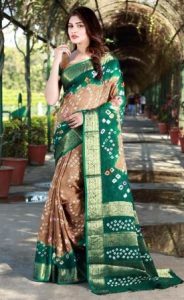
Image – Source
The Bandhani Saree is a popular traditional outfit for women in Gujarat, celebrated for its unique tie-dye patterns. The technique involves tying small sections of the fabric before dipping it in dye, resulting in intricate, dotted designs. Bandhani sarees are often worn during weddings, festivals, and other significant occasions.
These sarees are known for their bright colours, such as red, yellow, and green, often with contrasting borders and zari (gold or silver thread) work. The lightweight fabric, usually cotton or silk, makes it a comfortable choice for both everyday wear and special events. Bandhani sarees are also considered auspicious and are often gifted to brides.
Despite their long-standing tradition, Bandhani sarees have evolved over time, with modern adaptations featuring contemporary patterns and more vibrant hues. However, the essence of the Bandhani technique remains, making these sarees a symbol of Gujarat’s rich textile heritage.
Bandhani Saree Features
| Attribute | Details |
| Dress Name | Bandhani Saree (for women) |
| Cultural Importance | Known for its tie-dye technique, it holds a significant place in Gujarat. |
| Fabric & Material | Typically made from cotton or silk, depending on the occasion. |
| Key Design Features | Intricate tie-dye patterns, often with zari work. |
| Wearing Style | Draped traditionally, with the pallu often worn over the shoulder. |
| Special Occasion Use | Worn during weddings, religious ceremonies, and cultural festivals. |
| Cultural Accessories | Paired with traditional jewellery, such as bangles and necklaces. |
| Historical Background | Tie-dye technique dates back to ancient times, symbolising Gujarat’s art. |
| Regional Differences | Patterns vary depending on the region, with Kutch and Saurashtra having distinct styles. |
| Color Palette | Vibrant colours like red, yellow, and green, with contrasting borders. |
| Contemporary Trends | Modern adaptations with contemporary designs are gaining popularity. |
| Artisan Craftsmanship | Hand-tied and dyed by artisans, continuing a centuries-old tradition. |
| Comfort & Practicality | Light and airy, making it perfect for warm weather and festive celebrations. |
| Symbolic Meaning | Represents prosperity, femininity, and auspiciousness in Gujarati culture. |
| Festive Significance | A staple during important festivals like Navratri and Diwali. |
| Market Availability & Price | Available widely in markets and designer stores, with varying price points. |
5. Kediyu Angrakha (Men)
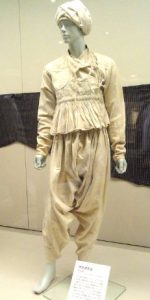
Image – Source
The Kediyu Angrakha is a more elaborate version of the traditional Kediya, featuring longer lengths and additional pleats.
This garment is typically worn during Navratri and other Gujarati festivals, where it is a staple of the energetic Garba and Dandiya dances. The extended length and extra flair make it a standout among traditional men’s attire in Gujarat.
This version of the Kediyu is usually made from cotton or silk and is often richly decorated with intricate embroidery or mirror work.
The loose-fitting garment allows for freedom of movement, making it a practical yet visually striking choice for dance and celebrations. Men often pair the Kediyu Angrakha with a Chorno or loose pyjama-like trousers, adding to the comfort of the ensemble.
In modern times, the Kediyu Angrakha has been embraced by designers, who create contemporary adaptations with detailed embellishments for a more stylish look.
Despite these updates, the garment continues to hold cultural significance, symbolising tradition and festivity in Gujarat’s vibrant culture.
Kediyu Angrakha Features
| Attribute | Details |
| Dress Name | Kediyu Angrakha (for men) |
| Cultural Importance | Worn during festivals, especially Navratri and Garba performances. |
| Fabric & Material | Typically made from cotton or silk, featuring embroidery and mirror work. |
| Key Design Features | Long, flared top with additional pleats and decorations. |
| Wearing Style | Paired with Chorno or pyjama-like pants, offering ease of movement. |
| Special Occasion Use | Primarily worn during festivals and religious celebrations. |
| Cultural Accessories | Often accessorised with a turban and light jewellery. |
| Historical Background | Evolved from traditional Kediya, with added embellishments for festivals. |
| Regional Differences | Variations in embroidery and pleating patterns across regions. |
| Color Palette | Bright colours like red, yellow, and green, adorned with mirrors. |
| Contemporary Trends | Modern designers create more embellished versions for fashion events. |
| Artisan Craftsmanship | Often hand-embroidered, crafted by local artisans for festivals. |
| Comfort & Practicality | Loose-fitting and lightweight, ideal for dance and celebrations. |
| Symbolic Meaning | Represents the festive spirit and cultural pride of Gujarat. |
| Festive Significance | A popular choice for Navratri, symbolising tradition and celebration. |
| Market Availability & Price | Easily available in markets during festival seasons, with premium options. |
6. Patola Saree (Women)
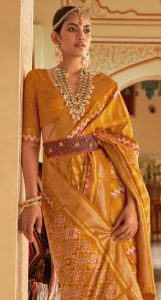
Image – Source
The Patola saree is a luxurious handwoven masterpiece originating from the Patan region of Gujarat. Known for its complex double ikat weaving technique, the Patola saree is highly prized for its intricate geometric patterns and rich colour palette.
These sarees are often worn by women during weddings and significant cultural events, symbolising wealth, tradition, and craftsmanship.
The process of creating a Patola saree is time-consuming, with artisans spending months hand-weaving each piece. The use of natural dyes and the precision required to achieve the double ikat design make these sarees both rare and valuable.
The patterns often feature motifs such as flowers, animals, and traditional symbols, which carry cultural and religious significance.
Although traditionally worn by brides and during festive occasions, modern adaptations of the Patola saree are also available for less formal events. Despite the changes in fashion, the Patola saree remains a symbol of Gujarat’s textile heritage and a testament to the skill of its weavers.
Patola Saree Features
| Attribute | Details |
| Dress Name | Patola Saree (for women) |
| Cultural Importance | Symbolises wealth, tradition, and Gujarat’s textile craftsmanship. |
| Fabric & Material | Made from silk, featuring intricate double ikat weaving. |
| Key Design Features | Geometric patterns, often featuring traditional motifs like flowers and animals. |
| Wearing Style | Draped traditionally, with a focus on displaying the saree’s rich patterns. |
| Special Occasion Use | Worn during weddings, cultural ceremonies, and festive occasions. |
| Cultural Accessories | Paired with heavy gold jewellery, particularly during weddings. |
| Historical Background | Originated in Patan, known for its double ikat technique. |
| Regional Differences | Designs and motifs vary slightly based on the region of production. |
| Color Palette | Rich colours like red, green, and gold, often with contrasting borders. |
| Contemporary Trends | Modern versions feature contemporary patterns, appealing to younger generations. |
| Artisan Craftsmanship | Handwoven by skilled artisans, with months of work involved in each saree. |
| Comfort & Practicality | Lightweight but luxurious, suitable for special occasions. |
| Symbolic Meaning | Represents prosperity, craftsmanship, and cultural heritage. |
| Festive Significance | A prized possession, especially during weddings and festivals. |
| Market Availability & Price | Available in high-end stores, with prices reflecting the craftsmanship involved. |
7. Paghdi (Headgear) (Men)
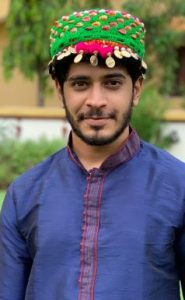
Image – Source
The Paghdi, or turban, is a significant traditional headgear worn by men in Gujarat. It symbolises honour, respect, and cultural pride and is often worn during formal occasions, such as weddings, religious ceremonies, and festivals.
The Paghdi varies in style, size, and colour, with each variation reflecting regional differences or social status.
Made from a long piece of fabric, the Paghdi is wrapped around the head in a specific manner, with the wrapping style differing from one region to another.
Brightly coloured Paghdis are often worn during celebrations, while simpler, plain ones may be worn on more sombre occasions. The headgear is not just a practical garment but also a cultural symbol, denoting the wearer’s role in the community.
In modern times, the Paghdi has retained its cultural importance and continues to be worn during traditional ceremonies.
While everyday use has declined, the turban remains an essential part of Gujarati weddings and festivals, symbolising respect and tradition in a rapidly changing world.
Paghdi Features
| Attribute | Details |
| Dress Name | Paghdi (for men) |
| Cultural Importance | Symbolises honour and respect, worn during formal occasions. |
| Fabric & Material | Made from cotton, silk, or synthetic blends, depending on the occasion. |
| Key Design Features | A long piece of fabric wrapped around the head, varying in style and colour. |
| Wearing Style | Wrapped in a specific manner, with variations based on region and status. |
| Special Occasion Use | Worn during weddings, festivals, and religious ceremonies. |
| Cultural Accessories | Often paired with traditional men’s attire like Kediya or Kurta. |
| Historical Background | A symbol of honour, rooted in Gujarat’s cultural and social traditions. |
| Regional Differences | Variations in style and colour across regions, reflecting local customs. |
| Color Palette | Bright colours like red, orange, and yellow for festivals, simple for other occasions. |
| Contemporary Trends | Less common in daily wear but remains a staple during formal events. |
| Artisan Craftsmanship | Often handmade, using local fabrics and traditional wrapping techniques. |
| Comfort & Practicality | Lightweight and adjustable, suitable for long wear during ceremonies. |
| Symbolic Meaning | Represents honour, community standing, and cultural pride. |
| Festive Significance | Essential part of men’s attire during major festivals and celebrations. |
| Market Availability & Price | Available in local markets, with prices depending on fabric and craftsmanship. |
8. Rabari Dress (Women)
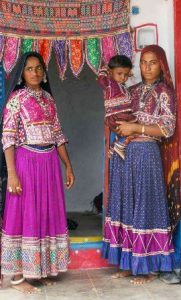
Image – Source
The Rabari dress is a unique and traditional outfit worn by the Rabari women, an indigenous community in Gujarat.
This attire reflects the rich cultural heritage of the Rabari tribe and is known for its distinctive embroidery, vibrant colours, and heavy mirror work. The Rabari dress typically consists of a long skirt, a blouse, and a dupatta, with each element intricately decorated.
The embroidery on the Rabari dress is done by hand, with mirrors and bright threads adding to the garment’s visual appeal.
The Rabari women often wear these outfits during everyday activities, as well as on special occasions and festivals. The style of the dress varies slightly across regions, but the use of vibrant colours and mirror work is consistent throughout.
In recent years, the Rabari dress has gained recognition beyond the community, with fashion designers incorporating elements of its unique style into modern designs.
However, the traditional version of the Rabari dress remains a symbol of tribal identity, representing the cultural richness of Gujarat’s rural communities.
Rabari Dress Features
| Attribute | Details |
| Dress Name | Rabari Dress (for women) |
| Cultural Importance | Represents the traditional attire of the Rabari tribal women in Gujarat. |
| Fabric & Material | Made from cotton, often featuring hand-embroidered designs. |
| Key Design Features | Long skirt, blouse, and dupatta, adorned with mirror work and embroidery. |
| Wearing Style | Worn with a dupatta draped over the head or shoulders. |
| Special Occasion Use | Worn during festivals, weddings, and important community gatherings. |
| Cultural Accessories | Paired with heavy jewellery, including silver necklaces and anklets. |
| Historical Background | Traditional dress of the Rabari tribe, passed down through generations. |
| Regional Differences | Variations in embroidery patterns across different Rabari communities. |
| Color Palette | Bright colours like red, orange, and green, highlighted with mirror work. |
| Contemporary Trends | Designers are incorporating Rabari embroidery into modern fashion. |
| Artisan Craftsmanship | Hand-embroidered by the women of the Rabari community. |
| Comfort & Practicality | Lightweight and durable, suitable for both everyday wear and festivities. |
| Symbolic Meaning | Represents the identity, strength, and resilience of Gujarat’s Rabari women. |
| Festive Significance | A key attire during tribal festivals and cultural celebrations. |
| Market Availability & Price | Available in rural markets, with variations in price based on craftsmanship. |
9. Eri Shawl (Men)
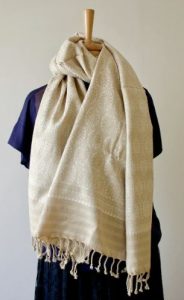
Image – Source
The Eri Shawl is a significant piece of traditional attire for men in Gujarat, particularly used as outerwear during the colder months or in regions where the climate is cooler.
Made from Eri silk or wool, the shawl is not only functional but also adds a layer of sophistication and cultural flair to men’s outfits. It is often paired with traditional attire such as the Kediyu or Kurta Pyjama.
The shawl is lightweight yet warm, and its soft texture makes it comfortable to wear over long periods. Traditionally, Eri Shawls are handwoven by artisans, and depending on the occasion, the shawls can be plain or adorned with intricate embroidery.
While they are practical for everyday wear in rural areas, they are also popular during festivals and formal gatherings.
In modern fashion, the Eri Shawl has found new admirers. Its versatility and aesthetic appeal make it a favourite for layering during colder weather, adding both style and a sense of tradition to any outfit. The shawl continues to be a staple in men’s traditional wardrobes, symbolising comfort and elegance.
Eri Shawl Features
| Attribute | Details |
| Dress Name | Eri Shawl (for men) |
| Cultural Importance | Worn as outerwear in colder regions, adds cultural flair to traditional outfits. |
| Fabric & Material | Made from Eri silk or wool, known for its softness and warmth. |
| Key Design Features | Lightweight, often plain or embroidered for formal occasions. |
| Wearing Style | Draped over the shoulders or wrapped around the upper body. |
| Special Occasion Use | Worn during winter months and festivals, often paired with traditional attire. |
| Cultural Accessories | Paired with Kediyu or Kurta Pyjama, and sometimes a turban. |
| Historical Background | Eri silk has been woven by artisans in Gujarat for generations. |
| Regional Differences | Variations in the fabric and embellishments depending on the region. |
| Color Palette | Neutral colours like cream, beige, and brown, with occasional vibrant patterns. |
| Contemporary Trends | Increasingly used in contemporary fashion as a layering accessory. |
| Artisan Craftsmanship | Handwoven by local weavers, often featuring traditional embroidery. |
| Comfort & Practicality | Soft, breathable, and lightweight, perfect for layering in cooler climates. |
| Symbolic Meaning | Represents simplicity, warmth, and the rural traditions of Gujarat. |
| Festive Significance | Popular during festivals and formal gatherings, especially in colder regions. |
| Market Availability & Price | Available in local markets and boutiques, with prices reflecting the craftsmanship. |
10. Chaniya Choli (Women)
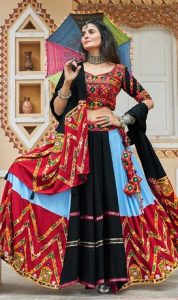
Image – Source
The Chaniya Choli is one of the most vibrant and popular festive outfits worn by Gujarati women, especially during Navratri.
It is a three-piece ensemble that includes a flared skirt (Chaniya), a fitted blouse (Choli), and a Dupatta. This outfit is richly adorned with embroidery, mirror work, and embellishments, making it the perfect choice for Garba and Dandiya performances.
The Chaniya Choli is known for its versatility in design and colours. Women often choose bright, contrasting colours like red, blue, yellow, and green to create a visually striking appearance.
The embellishments and embroidery on the Chaniya Choli reflect Gujarat’s artisanal heritage, with intricate patterns and vibrant designs making it a cultural favourite during festivals and weddings.
In modern times, fashion designers have reimagined the Chaniya Choli by incorporating contemporary fabrics, styles, and cuts while maintaining its traditional essence.
This has allowed the outfit to evolve with changing trends, making it a timeless symbol of Gujarat’s festive culture. The Chaniya Choli remains one of the most iconic representations of Gujarat’s rich textile and cultural history.
Chaniya Choli Features
| Attribute | Details |
| Dress Name | Chaniya Choli (for women) |
| Cultural Importance | A staple of festive attire for Gujarati women, especially during Navratri. |
| Fabric & Material | Made from cotton, silk, or synthetic blends, richly decorated with embroidery. |
| Key Design Features | A three-piece ensemble consisting of a flared skirt, blouse, and dupatta. |
| Wearing Style | Worn with a dupatta draped over the shoulder, often styled for dancing. |
| Special Occasion Use | Primarily worn during Navratri, Garba, and weddings. |
| Cultural Accessories | Paired with traditional silver jewellery, bangles, and anklets. |
| Historical Background | Dates back centuries, reflecting the festive spirit and cultural unity of Gujarat. |
| Regional Differences | Variations in embroidery and fabric depending on the region. |
| Color Palette | Bright, contrasting colours like red, yellow, green, adorned with mirror work. |
| Contemporary Trends | Modern versions feature lighter fabrics and more intricate detailing. |
| Artisan Craftsmanship | Handcrafted by artisans, with embroidery and mirror work being central elements. |
| Comfort & Practicality | Lightweight and comfortable, allowing free movement for dancing. |
| Symbolic Meaning | Represents the festive spirit, grace, and cultural pride of Gujarat. |
| Festive Significance | Essential attire for Navratri, symbolising celebration and tradition. |
| Market Availability & Price | Widely available during the festival season, with premium options for weddings. |
Conclusion
The traditional attire of Gujarat continues to thrive, bridging the gap between the past and present. Whether it’s the graceful Patola saree or the iconic Kediya, these garments are a testament to the state’s artistic heritage and cultural pride.
As festivals like Navratri and weddings bring communities together, these outfits take centre stage, embodying the vibrancy of Gujarat’s traditions.
By preserving and evolving these iconic dresses, Gujarat honours its history while embracing modern trends, ensuring that its traditional attire remains a cherished symbol of identity for generations to come.
FAQs
What Is the Traditional Dress for Men in Gujarat?
The traditional dress for men in Gujarat includes the Kediya, a short flared top, and Chorno, tight-fitting pants, usually worn during festivals like Navratri.
What Is a Patola Saree?
A Patola saree is a handwoven silk saree known for its intricate double ikat weaving technique, typically worn during weddings and special occasions.
When Do Women Wear Chaniya Choli in Gujarat?
Women wear Chaniya Choli during festivals like Navratri and weddings, where it is adorned with intricate embroidery and vibrant colours.
What Is the Purpose of the Paghdi in Gujarat?
The Paghdi is a traditional turban worn by men in Gujarat, symbolising honour and respect during festivals, religious ceremonies, and weddings.
How Is a Bandhani Saree Made?
A Bandhani saree is made through a tie-dye technique, where small sections of fabric are tied tightly and dyed, resulting in intricate dotted patterns.
What Is the Rabari Dress?
The Rabari dress is a traditional outfit worn by the Rabari women, featuring heavy embroidery and mirror work, symbolising Gujarat’s tribal heritage.
Why Is the Kediyu Angrakha Popular?
The Kediyu Angrakha is popular for its elaborate pleats and decorations, making it a festive favourite for Garba and other cultural celebrations.

